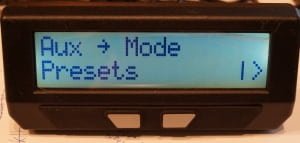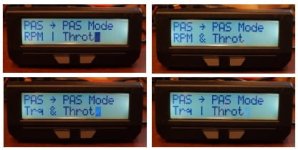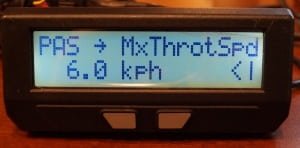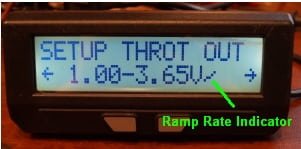Hey guys, I'm on the very last tweaks before going public with the B22 firmware, I just want to get a couple more days of folks here field testing so that we don't have any embarrassing bugs slipping by.
Thanks plenty for all the recent feedback and I think there is something here for everyone. In no particular order:
Auxilliary Voltage Preset Selection:

With this option the auxilliary voltage input doesn't control a limit but instead lets you select the current preset with a remote toggle switch. With 3 presets enabled, then >66% VAux is preset1, 33-66% VAux is preset2, and 0-33% VAux is preset 3. With only two preset enabled, then anything above 50% VAux is preset1, while anything below is preset2. If you change preset modes on the fly, then the main screen will briefly display the new preset name for about half a second to let you know what's up.
Default Preset on Power-Up:
View attachment 4
Choose if the CA boots up into preset1 by default or if it loads the same preset it was in when it shut down.
New PAS Modes:

For both the RPM or Trq control modes, you can choose whether you want this to be AND or OR'd to the throttle signal. Actually, that's not quite the case, in the Trq&Throt mode, pedaling without without the throttle will provide the assist, but if you throttle that only works while pedaling too. In both OR modes though, either pedaling without throttle or throttling without pedals will drive the bike.
Programmable PAS cutoff speed:

In either of the AND'd PAS+Throttle modes, you can set a maximum speed at which you can throttle without pedaling. So that should meet the varying legal pedalec classifications that have a maximum throttle-only speed. At the moment, once you exceed this speed and are not pedaling then the CA cuts out power abruptly, but I plan to have it use the smoother speed limiting PID loop in the future.
More info in PAS setup menu preview:
View attachment 1
The small 'P' and small 'D' both bounce up and down as the PAS and Direction signal alternate between 0 and 5V, and the current pas mode is shown as well
New Fast Ramp rate:
View attachment 5
Amberwolf, this one's for you! All the throttle ramps are now expressed in units of Second / Volt, so a higher number is a longer ramp time as had been often erreoneously assumed before, and it's in intuitive units. So if you set it to 2 seconds/volt, and your min to max output swing is 3 volts, then you know it will take 6 seconds to go from zero to full throttle.
The new 'Fast Ramp' option is a separate ramp up rate that the CA uses when it does not see any current draw. As soon as the CA senses more than 2 amps flowing from the controller, then it switches to the regular (presumably slower) ramp rate. Set correctly this eliminates the delay time that you otherwise need to wait if you have a slow throttle ramp but are already travelling at speed. The CA's output quickly gets to the point where it is drawing current, and then only slowly ramps from there on.
Having played around with this for a bit I can say I love it. It makes even a non-torque sensing PAS setup quite pleasant to ride. You can set a ramp time of like 3-4 seconds/volt which matches the natural acceleration of the bike, then taking off from a dead start it's exactly like what you do with the throttle, gradually ramping it up as you gain speed. But if you are already at speed and hit the throttle again, there is no annoying wait for the output to get to where it does something.
Finally, the setup menu preview for the throttle output also shows a little slanted bar graphic, and the faster the throttle ramp the steeper the slope:

-Justin
 then got called out to work..long shift..5 flights..emergency ones....might see things in a better light in the morning
then got called out to work..long shift..5 flights..emergency ones....might see things in a better light in the morning





